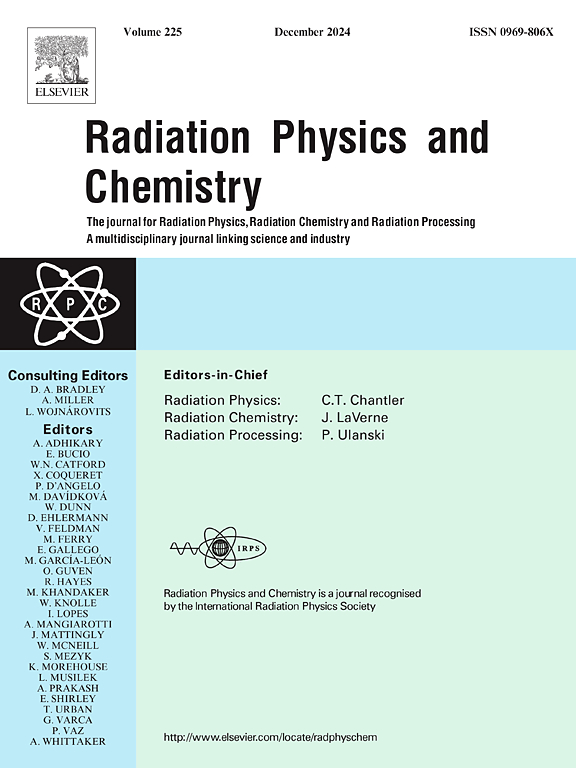氧化锌增强硼铁玻璃:通过实验和模拟方法对辐射屏蔽进行比较研究
IF 2.8
3区 物理与天体物理
Q3 CHEMISTRY, PHYSICAL
引用次数: 0
摘要
本文章由计算机程序翻译,如有差异,请以英文原文为准。
ZnO-enhanced borotellurite glasses: A comparative investigation of radiation shielding via experiment and simulation approaches
A lead-free glass series was fabricated according to the chemical formula of (40-x) B2O3+20 TeO2 + (20 + x + y) ZnO + (20 - y) CaO, where x = 0, 2, 4, and 6 mol% and y = 0, 3, 6, and 9 mol%. The role of substitution of ZnO for B2O3 and CaO compounds on the physical and radiation shielding properties of the prepared series was investigated. The density of prepared glasses was examined according to the Archimedes method. The increase in the ZnO across the concentration of 20–35 mol% increases the density of prepared glasses throughout 3.945–4.241 g/cm3. Furthermore, the radiation shielding capacities of the prepared glasses were examined through the experimental measurements using an NaI (Tl) detector and some radioactive sources, including Na-22, Ba-133, Co-60, and Cs-137. The data obtained from the experimental measurements was confirmed using Monte Carlo simulation and XCOM that depend on two various nuclear databases. The experiment, simulation, and XCOM calculations confirmed that the increase in the ZnO concentration throughout 20–35 mol% increases the linear attenuation coefficient throughout 0.352–0.367 cm−1 (at 0.511 MeV), 0.297–0.318 cm−1 (at 0.662 MeV), and 0.210–0.224 cm−1 (at 1.275 MeV), respectively. This increase in the linear attenuation coefficient improves the shielding capacity of prepared glasses, which reach 31.45 % (for the TeZn20 glass), 32.22 % (for the TeZn25 glass), 32.87 % (for the TeZn30 glass), and 33.65 % (for the TeZn35 glass) of the shielding capacity of pure lead at 0.662 MeV.
求助全文
通过发布文献求助,成功后即可免费获取论文全文。
去求助
来源期刊

Radiation Physics and Chemistry
化学-核科学技术
CiteScore
5.60
自引率
17.20%
发文量
574
审稿时长
12 weeks
期刊介绍:
Radiation Physics and Chemistry is a multidisciplinary journal that provides a medium for publication of substantial and original papers, reviews, and short communications which focus on research and developments involving ionizing radiation in radiation physics, radiation chemistry and radiation processing.
The journal aims to publish papers with significance to an international audience, containing substantial novelty and scientific impact. The Editors reserve the rights to reject, with or without external review, papers that do not meet these criteria. This could include papers that are very similar to previous publications, only with changed target substrates, employed materials, analyzed sites and experimental methods, report results without presenting new insights and/or hypothesis testing, or do not focus on the radiation effects.
 求助内容:
求助内容: 应助结果提醒方式:
应助结果提醒方式:


